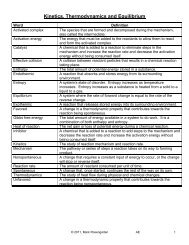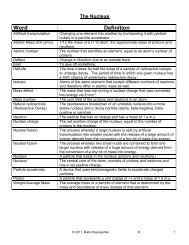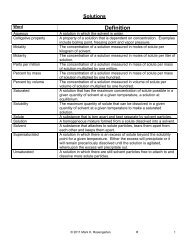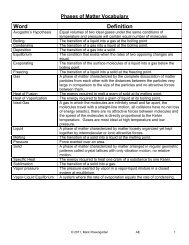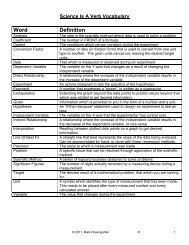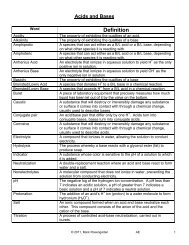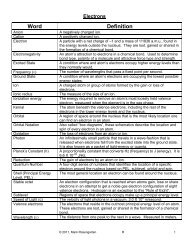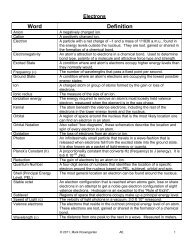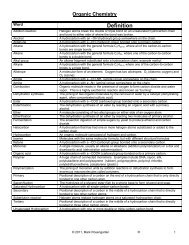Unit 11 - Mark Rosengarten
Unit 11 - Mark Rosengarten
Unit 11 - Mark Rosengarten
Create successful ePaper yourself
Turn your PDF publications into a flip-book with our unique Google optimized e-Paper software.
HOW DO WE KNOW IF A SOLUTION IS ACIDIC OR BASIC?<br />
1) pH probes<br />
pH probes contain an electrode that detects electrical conductivity. Before using this electronic device, it has to be<br />
calibrated by giving it a taste of two different solutions with different pH’s. These come in pocket devices that run on<br />
batteries or in computer interface probe form.<br />
A solution yields the following results when tested with various indicators:<br />
Methyl Orange = yellow<br />
Phenolphthalein = colorless<br />
Bromcresol Green = blue<br />
Thymol Blue = yellow<br />
Can the pH be:<br />
a) 2.8 b) 6.5 c) 8.5 d) 4.8<br />
2) Acid-Base Indicators and narrowing down pH using<br />
multiple indicators (mixture of indicators gives great range of<br />
colors, pH paper)<br />
Indicators are chemicals that have a certain characteristic color,<br />
depending on the pH. They can be used to determine if a solution<br />
is acidic or basic, or even to narrow the range of pH of a solution<br />
down. pH paper is paper soaked with a mixture of indicators that<br />
give a specific color at a specific pH, which is found on a chart on<br />
the pH paper bottle so you can compare the results to the chart.<br />
Litmus paper is paper soaked with litmus solution that has been<br />
allowed to dry.<br />
Methyl orange is RED from a pH of 3.2 or lower, and YELLOW<br />
from a pH of 4.4 or more. The middle of the range is an<br />
intermediate color (in this case, ORANGE).<br />
Well, let’s use the reference table to figure out at what pH the above indicators will be the specified colors.<br />
1) Methyl Orange = yellow at pH’s above 4.4 (it’s red at pH’s below 3.2 and changes from red to yellow<br />
between 3.2 and 4.4)<br />
Since the pH must be above 4.4, we can eliminate choice A.<br />
2) Phenolphthalein = colorless at pH’s below 8.2 (it’s pink at pH’s above 10 and changes from colorless to pink<br />
between 8.2 and 10)<br />
Since the pH must be below 8.2, choice C can be eliminated. Only choices B and D are left.<br />
3) Bromcresol Green = blue at pH’s above 5.4 (it’s yellow at pH’s below 3.8 and changes from yellow to<br />
green between 3.8 and 5.4)<br />
Since the pH must be above 5.4, choice D can be eliminated.<br />
The answer must be Choice B. Let’s see if that holds up with the last indicator:<br />
4) Thymol Blue = yellow at pH’s below 8.0, which 6.5 certainly is.<br />
The answer is therefore choice B, pH = 6.5.<br />
© 20<strong>11</strong>, <strong>Mark</strong> <strong>Rosengarten</strong> R 6



